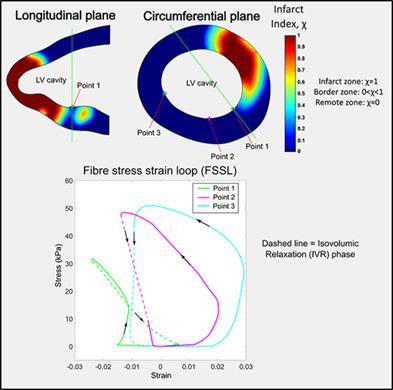当前位置:
X-MOL 学术
›
Int. J. Numer. Method. Biomed. Eng.
›
论文详情
Our official English website, www.x-mol.net, welcomes your feedback! (Note: you will need to create a separate account there.)
The role of regional myocardial topography post-myocardial infarction on infarct extension
International Journal for Numerical Methods in Biomedical Engineering ( IF 2.1 ) Pub Date : 2021-05-31 , DOI: 10.1002/cnm.3501 Chen Onn Leong 1 , Chin Neng Leong 2 , Yih Miin Liew 1 , Amr Al Abed 2 , Yang Faridah Abdul Aziz 3, 4 , Kok Han Chee 5 , Ganiga Srinivasaiah Sridhar 5 , Socrates Dokos 2 , Einly Lim 1
International Journal for Numerical Methods in Biomedical Engineering ( IF 2.1 ) Pub Date : 2021-05-31 , DOI: 10.1002/cnm.3501 Chen Onn Leong 1 , Chin Neng Leong 2 , Yih Miin Liew 1 , Amr Al Abed 2 , Yang Faridah Abdul Aziz 3, 4 , Kok Han Chee 5 , Ganiga Srinivasaiah Sridhar 5 , Socrates Dokos 2 , Einly Lim 1
Affiliation

|
Infarct extension involves necrosis of healthy myocardium in the border zone (BZ), progressively enlarging the infarct zone (IZ) and recruiting the remote zone (RZ) into the BZ, eventually leading to heart failure. The mechanisms underlying infarct extension remain unclear, but myocyte stretching has been suggested as the most likely cause. Using human patient-specific left-ventricular (LV) numerical simulations established from cardiac magnetic resonance imaging (MRI) of myocardial infarction (MI) patients, the correlation between infarct extension and regional mechanics abnormality was investigated by analysing the fibre stress–strain loops (FSSLs). FSSL abnormality was characterised using the directional regional external work (DREW) index, which measures FSSL area and loop direction. Sensitivity studies were also performed to investigate the effect of infarct stiffness on regional myocardial mechanics and potential for infarct extension. We found that infarct extension was correlated to severely abnormal FSSL in the form of counter-clockwise loop at the RZ close to the infarct, as indicated by negative DREW values. In regions demonstrating negative DREW values, we observed substantial fibre stretching in the isovolumic relaxation (IVR) phase accompanied by a reduced rate of systolic shortening. Such stretching in IVR phase in part of the RZ was due to its inability to withstand the high LV pressure that was still present and possibly caused by regional myocardial stiffness inhomogeneity. Further analysis revealed that the occurrence of severely abnormal FSSL due to IVR fibre stretching near the RZ-BZ boundary was due to a large amount of surrounding infarcted tissue, or an excessively stiff IZ.
中文翻译:

心肌梗死后局部心肌地形图对梗死扩展的作用
梗塞扩展涉及边界区 (BZ) 中健康心肌的坏死,逐渐扩大梗塞区 (IZ) 并将远端区 (RZ) 募集到 BZ,最终导致心力衰竭。梗塞扩展的潜在机制尚不清楚,但肌细胞拉伸被认为是最可能的原因。使用从心肌梗塞 (MI) 患者的心脏磁共振成像 (MRI) 建立的人类患者特异性左心室 (LV) 数值模拟,通过分析纤维应力-应变环来研究梗塞扩展与区域力学异常之间的相关性。 FSSL)。FSSL 异常使用定向区域外部工作 (DREW) 指数来表征,该指数测量 FSSL 面积和环路方向。还进行了敏感性研究,以研究梗塞僵硬对局部心肌力学和梗塞扩展潜力的影响。我们发现梗塞扩展与在靠近梗塞的 RZ 处呈逆时针循环形式的严重异常 FSSL 相关,如负 DREW 值所示。在显示负 DREW 值的区域,我们观察到等容松弛 (IVR) 阶段的大量纤维拉伸伴随着收缩期缩短率的降低。部分 RZ 在 IVR 阶段的这种拉伸是由于其无法承受仍然存在的高 LV 压力,并且可能是由局部心肌僵硬不均匀引起的。
更新日期:2021-05-31
中文翻译:

心肌梗死后局部心肌地形图对梗死扩展的作用
梗塞扩展涉及边界区 (BZ) 中健康心肌的坏死,逐渐扩大梗塞区 (IZ) 并将远端区 (RZ) 募集到 BZ,最终导致心力衰竭。梗塞扩展的潜在机制尚不清楚,但肌细胞拉伸被认为是最可能的原因。使用从心肌梗塞 (MI) 患者的心脏磁共振成像 (MRI) 建立的人类患者特异性左心室 (LV) 数值模拟,通过分析纤维应力-应变环来研究梗塞扩展与区域力学异常之间的相关性。 FSSL)。FSSL 异常使用定向区域外部工作 (DREW) 指数来表征,该指数测量 FSSL 面积和环路方向。还进行了敏感性研究,以研究梗塞僵硬对局部心肌力学和梗塞扩展潜力的影响。我们发现梗塞扩展与在靠近梗塞的 RZ 处呈逆时针循环形式的严重异常 FSSL 相关,如负 DREW 值所示。在显示负 DREW 值的区域,我们观察到等容松弛 (IVR) 阶段的大量纤维拉伸伴随着收缩期缩短率的降低。部分 RZ 在 IVR 阶段的这种拉伸是由于其无法承受仍然存在的高 LV 压力,并且可能是由局部心肌僵硬不均匀引起的。



























 京公网安备 11010802027423号
京公网安备 11010802027423号